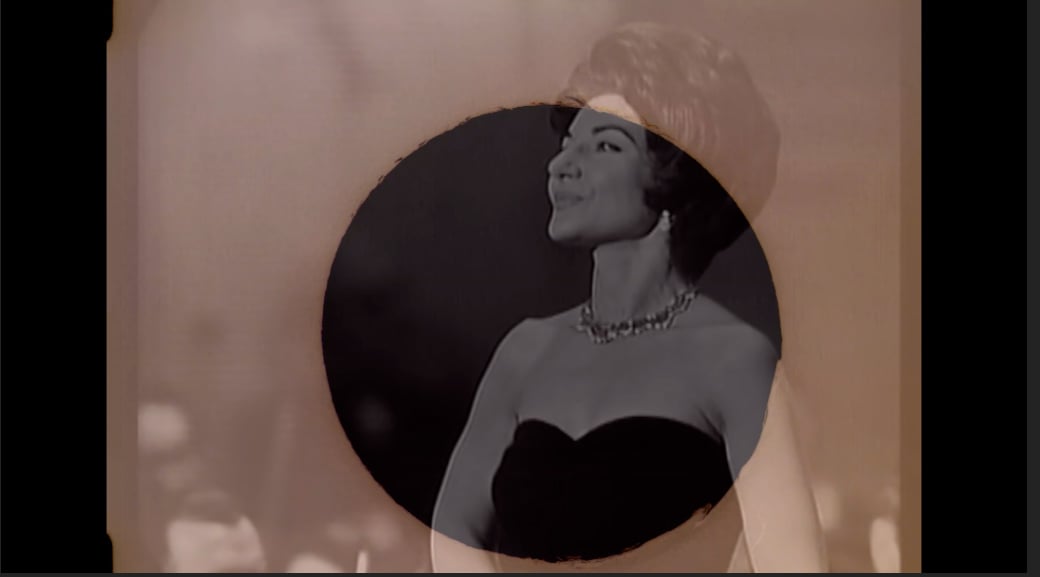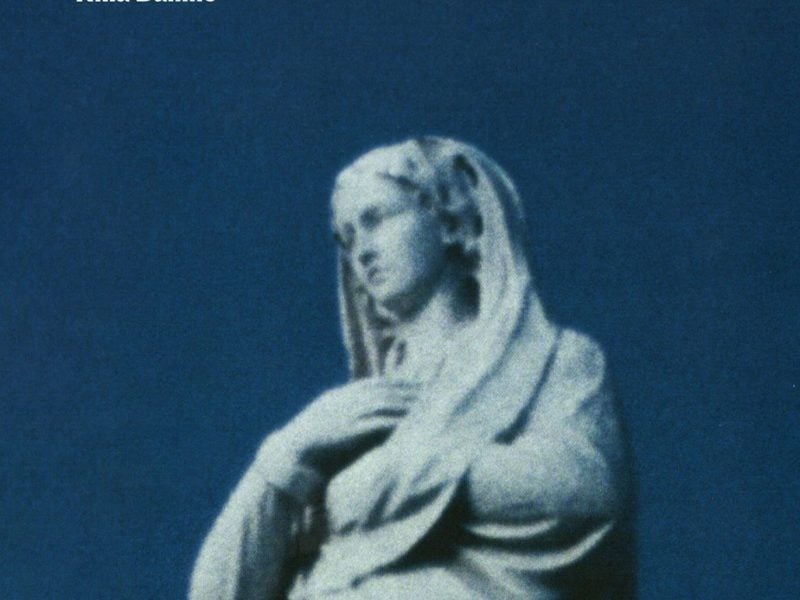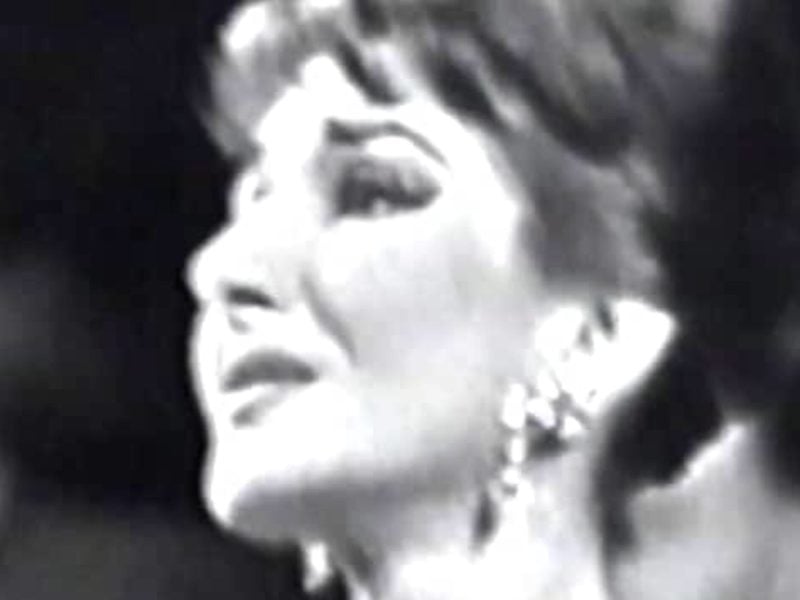Jo Blair interviews LUX artist Nina Danino about the release of her new feature film MARIA, a companion piece to SOLITUDE. MARIA will launch as a special event at Opera North on 14thDec with a Q&A. Both films are available now from LUX Distribution.
[addendum. in the audio interview there is a mention of Zed Zeppelin music which is no longer included in the film]
I understand that a key structural element informing MARIA, which explores aspects of the life and last days of renowned soprano Maria Callas, is the concept of iconostasis. Can you explain please what this is?
An Iconostasis is the wall of images; icons and paintings which in the Orthodox church divide the sanctuary from the nave. Rather than separating though, the Iconostasis is thought of as a connecting set of windows which are between the earthly and heavenly realm. Of course the iconostasis consists of images of saints, apostles, Virgin Mary, Christ, Patriarchs and prophets in Eastern Christianity. The icon is not just an art work but a sacred image for contemplation.
How did you use Iconostasis as a structure here, and why choose this concept for this particular project?
MARIA is constructed in panels each made up of a different opera performance by Callas, sections from Pier Paolo Pasolini’s Medea (1969) and a section in Pere Lachaise, thinking of Stan Brakhage’s The Dead (1960) with flashing images. The structure of an iconostasis can also help to think about the exhibition of the film. The concept of the iconostasis offers the possibility of considering characteristics of structural film and of experimental film such as duration, stasis, the suppression of high key signifiers, use of colour filters, the craft of image-making, flatness, representation, distance, framing. The word icon adds the notion of aura, the image as presence and the iconostasis a set of windows, a door or a portal. And the icon itself is held as an image of/for contemplation. But it’s more than the use of duration which can have this effect in bringing an image to a viewer for meditation or non-entertainment viewing. As Maria Callas is already an icon, we are placing an icon in an iconostasis. What happens when the image of a secular icon is positioned in the concept of iconostasis in cinema? In theology, how do images become icons and what is the difference between an image and an icon?
How did you transfigure the image of Maria Callas? And why?
In MARIA, I used archive footage of performances, which I transformed through experimental techniques of superimposition, positive/negative intercutting, solarisation, use of colour filters, flicker, flaring and slow motion. The new footage on 16mm uses hand held camera and was mostly in camera edited and included in the order shot as rushes with use of leader. MARIA revisits the mechanical and objective foundation of the London Filmmakers’ Co-op’s experimental techniques. I wanted to use the optical printer but the process would have been very slow and costly. However, the images are made through intense and close work. The flicker of Tosca was made frame by frame and by laying different tracks of colour, using different opacities, the superimpositions by stacking layers and layers of images, the intercutting of negative and positive of the 16mm footage in Pere Lachaise is done in short bursts. The solarisation is not done by pressing an effect on Resolve as none exists. These transfigurations were done through close work. This work transfigures the image of Callas.
I also wanted to stand in front of the icon through experimental film to bring a new perspective on Callas and to produce a new icon which reveals itself.
MARIA is a diptych with SOLITUDE (2022) which you made with Nico (Velvet Underground) as screen, poet, muse. What is the relationship between these two projects? How did they evolve together creatively and – now finished – how do they interrelate?
They are separate projects but have connections. I wrote a treatment for MARIA rather than a scripted film – in 2015 and started a film draft of MARIA with my company Temporal Films. Tony Palmer the director gave me the transcripts to his documentary on Callas, Maria Callas – La Divina (1987) and the curator Sarah Perks got involved to help to realise the project. I applied to the BFI three times but I had to set it aside. In the meantime in 2020, I had started SOLITUDE as songs. This was funded by the Arts Council for a film which was completed in 2022. MARIA became possible with an Exceptional Award from Goldsmiths in 2023.
Both films deal with the cult of these two figures, a cult of worship and devotion in different ways. There is also my interest in their voices, iconicity and in film itself, also the screen in both works is important. In SOLITUDE Nico is surface and in MARIA, Maria Callas is transfigured and as an icon it is her image we are concerned with, as a route to the emotion in her voice. They are also my muses and portals. Laura Staab in ‘Nico in Dark Times’ says that SOLITUDE sanctifies Nico in devoted compassion. There is a worship of Callas and the images created of a Callas transfigured.
You also appear in both films. How would you describe your ‘appearance’, perhaps in relation to past films you’ve made?
It is different to the enveloping act of self-inscription in my film about St Teresa, “Now I Am Yours” (1992), which was through techniques of fast editing and other means. I wanted to return to self-inscription and ecstasy but then St. Teresa is a mystic where the body is at the centre and an icon is an image. In MARIA and SOLITUDE I am presenting icons and I enter the domain through the reading of poetry. I perform Nico’s songs for SOLITUDE and a monologue and film self-portraits in Pere Lachaise against the stones in MARIA.
Each work has screenings or will have screenings independently, with more surely to come. But what would be your ideal scenario for presenting the two together to audiences/viewers?
MARIA and SOLITUDE are feature length for cinema screening and thus can be shown together. Solitude has a 5:1 soundtrack and MARIA gives a visual experience. Both films also work on a monumental scale – so they can occupy a large perhaps industrial space or as an off-site project for a gallery. MARIA is suited to gallery exhibition as an iconostasis with sections on multiple screens as audiences expect shorter pieces in a gallery. SOLITUDE can be performed with live music as it did for its launch with Gagarin (Graham Dowdall) performing the soundtrack. So they are formally different but inform each other, and of course, the films are also research full so could be presented in conferences or symposia on film, voice, music and gender studies.
You’ve mentioned the ‘daemonic’ aspect of Callas’ power – can you expand on this?
Caitlin Malfitano refers to the drives in Callas as burning – “She burned herself up in her own pursuit to grab and embrace life, to taste everything. I don’t think anyone can survive that kind of drive”. There is the drive also which is conveyed in the communication of emotion and Callas, contrary to the voice she is known for, has a dramatic range which is ‘rather dark, moody and penetrating, very different from the light agile and lyric voices of coloratura sopranos” (Wink, Prima Donna, 2020). According to Wink, even Callas herself was disturbed when she first heard it. You can hear it descend into deep dark and heavy tones in the stabbing of Scarpia in Act II of Tosca in MARIA. I think the daemonic is there in the drive and the will to power of Callas as well as expressed in the deep contralto descent of the voice into something frightening as well as her ‘screaming’ voice. I’m interested in these extremes of voice.
With SOLITUDE, you collaborated closely with Graham Dowdall amongst others on the score. Who have your main collaborators been on MARIA for music and sound and how have you worked together?
Apart from the existing recordings by Maria Callas, the sound track to MARIA has Pier Paolo Pasolini’s Medea soundtrack as a backing track. In 2020, I started close work of studying and deconstructing it and re-constructing it into the instrumentals, fx, vocals and creating eight songs and librettos for a singer and instrumentals. Margaret Birley (Keeper of Musical Instruments at the Horniman Museum) was incredibly helpful in identifying the different instruments. The soundtrack was intended for Sainkho Namtchylak to interpret and I sent her the libretto. But as it wasn’t funded it was not possible. When the Goldsmiths award came through it became possible to work with traditional musicians in London. James Bulley from 2020 had done the draft pre-mix and he largely found the singers and instrumentalists according to the libretto which were Iranian love songs, sacred Japanese chants,Tibetan sacred chants and Bulgarian voices. The pieces were recorded in St. Catherine’s Church, New Cross. It’s a project within a project and a massive undertaking. The instruments are: koto by Keiko Kitamura, shurangiz by Vahid Taremi, santur by Peyman Heydarian, Carnatic singer Yarlinie Thanabalasingam, Bulgarian voices Lori Secanska, Alex Gibson and Polly Hunt from the London Bulgarian Choir. What I found most exciting was to create cross pieces between these traditions, for example Yarlinie did vocals with the shurangiz which is an Iranian instrument, and with the Bulgarian voices. So there is traditional music and experimental new pieces. I do spoken lines and vocals, and the Iranian love song. We also recorded percussion such as bells and so on and I bought several wonderful pieces of Tibetan and Indian jewellery in Barbagallo’s Notting Hill for the all-important ornament motif which is so much part of Medea. It is a work within the work. I hope to release it as an album or in an installation. It was wonderful to have done and thanks to James Bulley for the superb crystalline recordings and finding excellent instrumentalists and singers with whom it was such a pleasure to work.
You’ve also included music by The Doors in MARIA. What was the thinking behind this decision?
I arrange the music, spoken word and other sounds in my soundtracks. The Doors provide one of a number of portals through their music as a drive.
Maria Callas is a signifier too for this reach where speech breaks off into another form of expression. I stand facing her in MARIA and facing Nico too in her own way, as a force, in SOLITUDE. I see them, The Doors and Jim Morrison in particular – a beautiful man, who was pursuing psychedelic ecstasy through his performances – as emblems of my own creative and deathly drive, looking for where words cannot reach.






